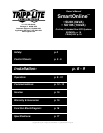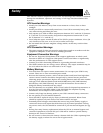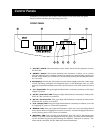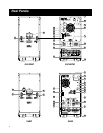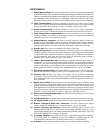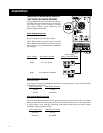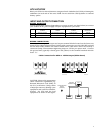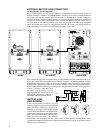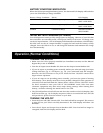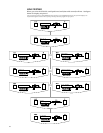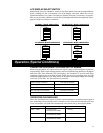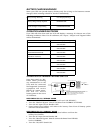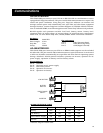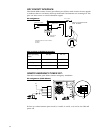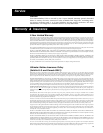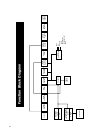5
1. Manual Bypass Switch: This red and yellow dial is used in one step of putting the UPS
in "BYPASS” mode, which must be done before performing any maintenance on the UPS
with the connected load supported. (See page 12 for step-by-step instructions for going
into "BYPASS.") While this switch is on "BYPASS," connected equipment will receive
filtered AC mains power, but will not receive battery power in the event of a blackout.
2. Input Terminal Block: Use these terminals to connect your UPS to the AC main
power input. Unscrew and remove terminal block plate for access. The optional SUBP
battery pack's IEC-320 connector accepts its charger's input power cord.
3. Output Terminal Block: Use these terminals to connect your UPS to equipment.
A plate covering the terminal block must be unscrewed and removed for access.
4. Input Voltage Select Terminal Block: Use these terminals to set your UPS's to
receive your 208V AC or 240V AC line voltage. A plate covering the terminal block
must be unscrewed and removed for access.
5. External Battery Connector: Use this to connect Tripp Lite Battery Packs. The
SU10K requires a SU10KBP or SUBP to operate; additional SUBP's can be added to
SU6K or SU10K systems for extra runtime. Refer to instructions available with the
optional SUBP Battery Pack for connection instructions and safety warnings.
6. Exhaust Fan: This cools and ventilates the inside of the UPS.
7. AS-400 Interface Port: This female DB9 port connects your UPS to an IBM AS-400
computer interface via the AS-400 Cable included. It uses AS-400 communications
to report UPS status and power conditions. Using this port, an IBM AS-400 computer
can automatically save open files and shut down its operating system during a
blackout. See "Communications," pg. 13, for details.
8. “Smart” RS-232 Interface Port: This female DB9 port connects your UPS to a
workstation or server. It uses RS-232 communications to report UPS and power
conditions. It is used with Tripp Lite software and the included RS-232 Cable to
monitor and manage network power and to automatically save open files and shut
down equipment during a blackout. See "Communications," pg. 13, for details.
9. Dry Contact Interface Port: This female DB9 port sends contact-closure signals to
indicate line-fail and low-battery status. See "Communications," pg. 14, for details.
10. Accessory Slot: Remove the small cover panel and use optional accessories
to remotely control and monitor your UPS. Contact Tripp Lite Customer Support for
more information and a list of available SNMP, network management and connec-
tivity products.
11. “Battery Start” Switch: This momentary rocker switch allows you to “cold-start” your
UPS and use it as a stand-alone power source when utility-supplied AC power is not
present. The switch enables the UPS’s DC/AC Inverter. Before “cold-starting” your
UPS, make sure your UPS and external battery cabinets are properly installed. Press
and hold the “Battery Start” Switch and then press the “ON/OFF” switch to turn your
UPS ON. To turn it OFF after “cold-start,” press the “ON/OFF” Switch.
12. Battery Fuses (SU6K & SUBP's Only): The 30A/600V fuses protect your connected
battery or battery bank.
13. AC Input Breakers: One double-pole circuit breaker controls input power to the UPS.
14. AC Output Breaker: Triple-pole circuit breakers control output power from the UPS.
15. Remote “Emergency Power OFF” Connector: This RJ11 modular jack allows
remote emergency shutdown. See "Communications," pg. 14, for details.
16. Inverter Operation DIP Switches: Behind this removable panel are four DIP
Switches that should be set to match your input voltage and input frequency. Your
input voltage and frequency DIP switch settings MUST match your input. Your UPS
WILL NOT CONVERT the voltage or frequency.
17. Grounding Terminal: This terminal connects to a grounding electrode conductor.
IT IS NOT SAFE TO OPERATE YOUR UPS WITHOUT CONNECTING IT. The
recommended conductor size is 8 AWG based on the UL 1778 standard.
18. Stabilizers: These supports extend to keep your UPS from rolling or tipping.
REAR PANELS



